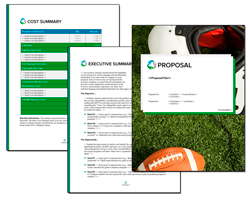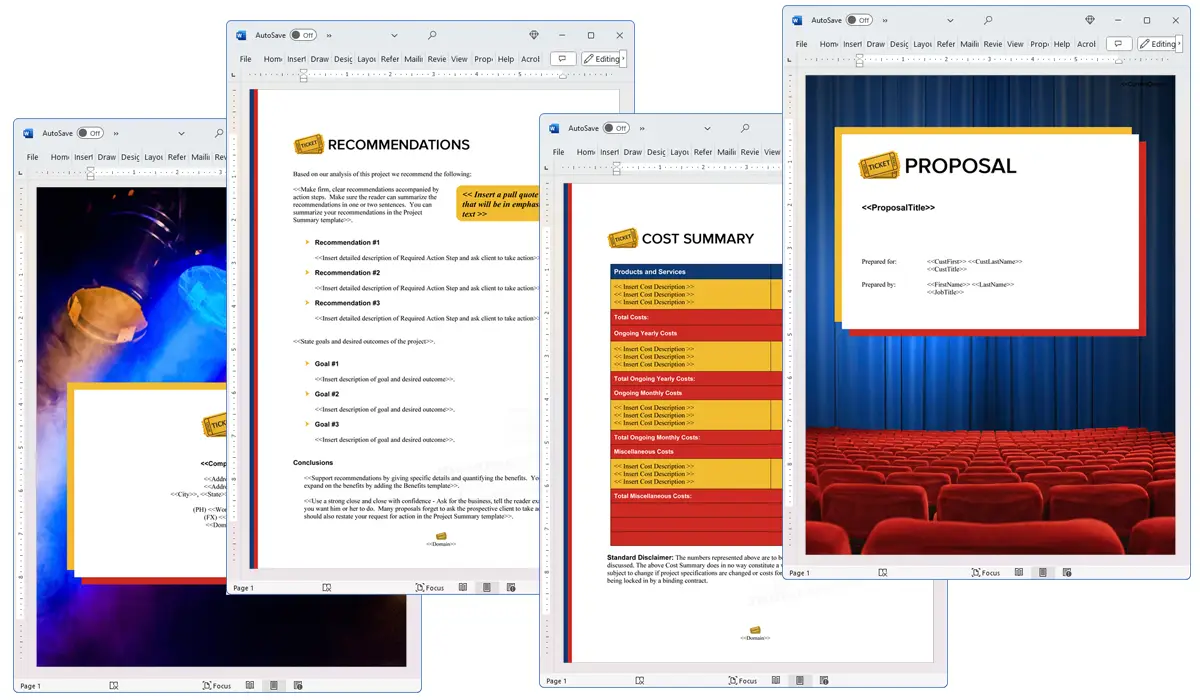What is the Disaster Recovery chapter used for?
Proposal Kit Professional Bundle adds more design themes, all six Contract Packs,
a project management library, and Expert Edition software.

Illustration of Proposal Pack Children #3
We include this Disaster Recovery chapter template in every Proposal Pack, along with thousands more. You assemble this chapter with others in various combinations to create custom-tailored business proposals, plans, reports, and other documents. Proposal Packs apply custom visual designs to the templates, giving the final documents a consistent professional finish.
 DOWNLOADABLE, ONE-TIME COST, NO SUBSCRIPTION FEES
DOWNLOADABLE, ONE-TIME COST, NO SUBSCRIPTION FEES
Overview of the Disaster Recovery Chapter
The Disaster Recovery chapter is an important part of any business proposal that addresses preparedness and responsiveness to unexpected crises that could impair a company's operations. This chapter sets the stage for discussing how a business plans to recover from various disasters, ensuring minimal disruption to its operations. By introducing the topic of disaster recovery, this chapter provides a framework to subsequently detail a comprehensive recovery plan.
How is the Disaster Recovery Chapter Used?
When used in a business proposal, the Disaster Recovery chapter is used to reassure potential clients or partners of a business's resilience and foresight. It highlights the organization's strategies for dealing with potential disasters that could affect business continuity. This chapter helps to build trust by showing preparedness in the face of adversity, which is crucial for securing contracts or investments, particularly in industries where reliability and uptime are critical.
What is Included in the Disaster Recovery Chapter?
The Disaster Recovery chapter typically includes:
- An introduction to the importance of disaster recovery planning.
- A description of the types of disasters that could potentially affect the business, such as natural disasters (floods, hurricanes, tornadoes), technological issues (data theft, computer viruses), and other operational disruptions (fire, power outages).
- An outline of the impact these disasters could have on the normal operations of the business.
- Details of the planned responses and recovery strategies to mitigate these impacts.
- Specific steps and measures that will be implemented to ensure quick recovery and continuity of operations.
Use Case Examples for the Disaster Recovery Chapter
- Web and IT Services: For companies providing web hosting or IT services, detailing how data centers are protected against power outages and cyber threats.
- Software and Hardware: Proposals for software solutions can include protocols for data backup and recovery post-cyber attacks, while hardware proposals might focus on physical security and fire safety systems in warehouses.
- Technical and Security Solutions: Highlighting the technical measures in place to safeguard sensitive information and systems against hacking or data breaches.
- Protection and Safety Services: For businesses offering security and safety solutions, demonstrating how their services can be integral during emergency evacuations or in recovery operations.
- Action and Response Plans: Outlining specific emergency response actions for businesses in sectors like manufacturing, where physical assets are at risk from natural disasters.
Key Takeaways
- The Disaster Recovery chapter is crucial for showcasing a business's preparedness for unexpected events.
- It builds confidence among potential clients or investors about the business's ability to maintain continuity under adverse conditions.
- This chapter covers a range of potential threats, from natural disasters to technological disruptions.
- Including a Disaster Recovery chapter is particularly relevant in proposals for services dependent on high uptime and reliability.
- The chapter serves as both a and operational roadmap for mitigating the effects of disasters on business operations.

Illustration of Proposal Pack Sports #8
 What Our Clients Say
What Our Clients SayI bought the Proposal Pack in June and found it to be very useful for creating professional-looking customer proposals. The proposal wizard makes it extremely simple to create a complex proposal. It also provides a lot of flexibility in customizing the proposal to match the project at hand. I am sure to be using it for every singly deal where a comprehensive proposal is to be submitted to a customer, as it saves a lot of time. I am happy to recommend it to anyone who is looking for assistance in creating customer proposals that look professionally done."
 4.7 stars, based on 849 reviews
4.7 stars, based on 849 reviewsAlternate Chapters
Related Chapters
- Disaster Recovery Plan
- Emergency Response Plan
- Evacuation Plan
- Security Plan
- Safety Plan
- Rescue Plan
- First Response
- Threat Assessment
- Loss Prevention
- Protective Measures
- Risk Analysis
- Risk Management
- Damage Control
- Disaster Relief
- Humanitarian Efforts
- Contingency Planning
- Downtime
- Response Time
- Preparedness
- Continuity
- Escape Routes
- Disruptions
- Outages
- Natural Disasters
- Containment
- Emergencies
- Aid Package
- Relief
- Emergency Team Members
- Resettlement
- Resource Sharing

The Disaster Recovery chapter and other chapters are integrated into a Word document as illustrated here in the Proposal Pack Entertainment #8 design theme. There are hundreds of design themes available, and every design theme includes the Disaster Recovery chapter template.
A proper business proposal will include multiple chapters. This chapter is just one of many you can build into your proposal. We include the complete fill-in-the-blank template in our Proposal Pack template collections. We also include a library of sample proposals illustrating how companies in different industries, both large and small, have written proposals using our Proposal Packs. This template will show you how to write the Disaster Recovery.
We include a chapter library for you to build from based on your needs. All proposals are different and have different needs and goals. Pick the chapters from our collection and organize them as needed for your proposal.
Using the Proposal Pack template library, you can create any business proposal, report, study, plan, or document.
The Wizard software includes an AI Writer, which will write the content of this and any other chapter of your document. Use the AI Writer to do the heavy lifting, writing the first draft of your proposal or business document in minutes.
 Ian Lauder has been helping businesses write their proposals and contracts for two decades. Ian is the owner and founder of Proposal Kit, one of the original sources of business proposal and contract software products started in 1997.
Ian Lauder has been helping businesses write their proposals and contracts for two decades. Ian is the owner and founder of Proposal Kit, one of the original sources of business proposal and contract software products started in 1997.By Ian Lauder
 Published by Proposal Kit, Inc.
Published by Proposal Kit, Inc.


 Cart
Cart
 Facebook
Facebook YouTube
YouTube Bluesky
Bluesky Search Site
Search Site